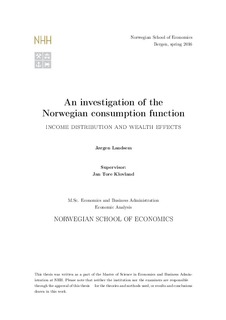An investigation of the Norwegian consumption function : income distribution and wealth effects
Master thesis
Permanent lenke
http://hdl.handle.net/11250/2403312Utgivelsesdato
2016-09-01Metadata
Vis full innførselSamlinger
- Master Thesis [4372]
Sammendrag
Since the financial crisis, Norwegian private consumption has fallen as a
share of disposable income. This weak development in consumption was not
predicted by the contemporaneous consumption models and led to a “structural
breakdown” of these models. This master’s thesis will attempt to build
a new model for aggregate consumption that is better able to explain the
developments since the financial crisis. This is done by using cointegration
analysis to estimate a long run relationship and then include this in an error
correction model for private consumption. With a basis in the current consumption
function in Statistic Norway’s KVARTS model, I first show the
breakdown of the contemporaneous model and then conduct two separate
analyses into possible explanations for the breakdown. First, I find that the
income distribution, measured by a Gini coefficient or the wage share, do
not seem to affect household consumption on the aggregate level. Second,
I split the wealth variable present in the current model into different components.
In the long run, including net housing wealth and net financial
wealth separately seems to improve the model. Financial wealth is a larger
determinant of household consumption in the long run than housing wealth.
In the short run, the degree of liquidity affects the effect of financial wealth
on consumption, while controlling for short run dynamics of debt does not
improve the model.
